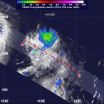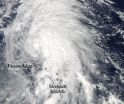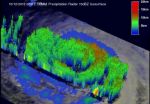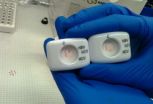(Press-News.org) NEW ORLEANS — Curtailing the imminent rise in Alzheimer's disease (AD) will require early, accurate diagnostic tests and treatments, and researchers are closer to achieving these two goals. New findings in medical imaging, molecular analysis of neurological diseases, and development of treatments using mouse models were presented at Neuroscience 2012, the annual meeting of the Society for Neuroscience and the world's largest source of emerging news about brain science and health.
AD is the most common cause of dementia and currently affects 5 million people in the United States. By 2015, this number could increase to 13 million people.
Today's new findings show that:
Changes in brain function occur many years before symptoms in people with AD; these changes could be detected by PET scans and might one day be used to identify people at risk for developing the disease (Lori Beason-Held, PhD, abstract 545.22, see attached summary).
A new drug that targets biochemical changes in proteins improved symptoms and increased survival in a mouse model of AD, but just how it works is a mystery (Fred Van Leuven, PhD, abstract 416.08, see attached summary).
An antibody-based probe that uses nanotechnology and magnetic resonance imaging can distinguish between diseased and non-diseased brain tissue and could lead to a test for early detection of AD (William Klein, PhD, abstract 753.21, see attached summary).
AD, Parkinson's disease, and Dementia with Lewy Bodies have specific molecular signatures caused by epigenetics — mechanisms that determine how and when DNA is expressed — that could assist in accurate diagnosis and earlier treatment (Paula Desplats, PhD, abstract 50.17, see attached summary).
A new mouse model for AD gives researchers more control over an Alzheimer's-related protein in mice, and could lead to better research on effective treatments (Alena Savonenko, MD, PhD, abstract 416.04, see attached summary).
"Being able to detect AD early — perhaps even before symptoms begin — is an essential pre-condition if we are to develop effective treatments that slow or stop the changes that occur in the brain during Alzheimer's. Our studies in mice already tell us this," said press conference moderator Sam Gandy, PhD, MD, of the Mount Sinai School of Medicine in New York City, an expert on AD and dementia. "Being able to distinguish AD from other neurodegenerative diseases will help us give the right treatments to the right patients."
###
This research was supported by national funding agencies such as the National Institutes of Health, as well as private and philanthropic organizations.
Todd Bentsen, (202) 962-4086
Press Room, Oct. 13-17: (504) 670-4630
END
NEW ORLEANS — Research released today demonstrates how new scientific knowledge is driving innovative treatments for spinal cord injuries. Spinal cord damage is debilitating and life-altering, limiting or preventing movement and feeling for millions worldwide, and leading to chronic health conditions and pain. The new studies suggest potential therapies for managing the aftermath of pain and pressure sores, repairing nervous system damage, and speeding recovery. The findings were presented at Neuroscience 2012, the annual meeting of the Society for Neuroscience and the ...
NEW ORLEANS — New animal studies provide additional support for investigating stem cell treatments for Parkinson's disease, head trauma, and dangerous heart problems that accompany spinal cord injury, according to research findings released today. The work, presented at Neuroscience 2012, the annual meeting of the Society for Neuroscience and the world's largest source of emerging news about brain science and health, shows scientists making progress toward using stem cell therapies to repair neurological damage.
The studies focused on using stem cells to produce neurons ...
(Garrison, NY) Personalized genomic medicine is hailed as a revolution that will empower patients to take control of their own health care, but it could end up taking control away from patients and limiting their treatment choices, concludes an article in the Hastings Center Report. A commentary responding to the article, by the editorial director of Health and Family at Consumer Reports, also appears in the journal.
Genomic science provides two categories of data, the authors write: pharmacogenomic information and genomic susceptibility information. Pharmacogenomic ...
Tropical Storm Maria was born in the western North Pacific Ocean and has a large area of moderate rainfall, as NASA's TRMM satellite revealed today, Oct. 15. NASA's TRMM satellite noticed that most of Maria's rainfall was occurring northeast of the storm's center. Maria is the twenty-third tropical cyclone of the western North Pacific season.
When NASA's Tropical Rainfall Measuring Mission (TRMM) satellite passed over Tropical Storm Maria on Oct. 15 at 1329 UTC (9:29 a.m. EDT) light to moderate rainfall was occurring northeast of the center and falling at a rate between ...
Tropical cyclones seem to love forming over weekends, Rafael formed over the weekend in the Atlantic, Anais in the Southern Indian Ocean and Hurricane Paul in the eastern Pacific Ocean. NASA's Terra satellite kept on top of Paul, however, and provided forecasters with a visible look at the newborn storm.
Paul formed on Oct. 13 at 5 p.m. EDT about 660 miles (1,065 km) south-southwest of the southern tip of Baja California, near 14.0 North and 113.6 West.
The Moderate Resolution Imaging Spectroradiometer (MODIS) instrument aboard NASA's Terra satellite captured a visible ...
While the Leeward Islands continue to get battered by Tropical Storm Rafael, a Tropical Storm Watch is posted for Bermuda as Rafael continues to move through the eastern Atlantic Ocean. NASA's Aqua satellite passed over Rafael on Oct. 14 and noticed the bulk of showers and thunderstorms were being pushed north and east of the storm's center.
The Moderate Resolution Imaging Spectroradiometer (MODIS) instrument aboard NASA's Aqua satellite captured a visible image of Tropical Storm Rafael in the Atlantic Ocean on Oct. 14, 2012 at 1720 UTC (1:20 p.m. EDT). The image clearly ...
Tropical Cyclone Anais, the first tropical cyclone of the Southern Indian Ocean's tropical cyclone season, has strengthened over the weekend of Oct. 13 and 14 and by Oct. 15, the storm was packing sustained winds near 100 knots (115 mph/185 kph).
The Moderate Resolution Imaging Spectroradiometer (MODIS) instrument aboard NASA's Aqua satellite captured a visible image of Tropical Cyclone Anais off Madagascar on Oct. 15 at 0940 UTC (5:40 a.m. EDT) and revealed an eye. Multi-spectral satellite imagery showed that convection has continued to decrease around Anais' ragged ...
Typhoon Prapiroon has been meandering in the western North Pacific Ocean over the weekend of Oct. 13 and 14, and NASA's TRMM satellite was able to identify where the strongest rainfall was occurring in the storm.
The Tropical Rainfall Measuring Mission (TRMM) satellite passed directly above weakening Typhoon Prapiroon in the western Pacific Ocean on October 12, 2012 at 0741 UTC (3:41 a.m. EDT). At that time, Typhoon Prapiroon was a powerful category two typhoon on the Saffir-Simpson scale with winds slightly less than 95 knots (~109 mph).
A 3-D image of the storm was ...
Montreal October 15, 2012 – Timely screening and diagnosis is critical to the success of new treatments and ultimately to the survival of hepatitis C patients. A new study led by the Research Institute of the McGill University Health Centre (RI MUHC) is the first to show that hepatitis C rapid and point of care tests with a quick turnaround time are highly accurate and reliable as conventional first-line laboratory tests. This head-to-head analysis, published in the current issue of the Annals of Internal Medicine, will lead to changes in screening practices and ultimately ...
The genomes of birds are riddled with DNA sequences from viruses, according to a study to be published on October 16 in mBio®, the online open-access journal of the American Society for Microbiology. Analysis of these viral sequences, known as endogenous retroviruses (ERVs), can provide insights into how both hosts and viruses have evolved over the eons.
"We examined the evolution of avian retroviruses on the basis of their fossil remnants in the three avian genomes that have been completely sequenced," write the authors from Johns Hopkins University and Uppsala University, ...





